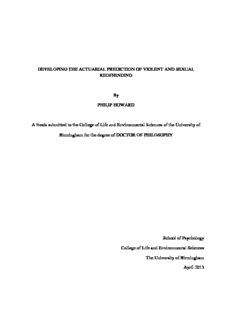
Developing the actuarial prediction of violent and sexual reoffending PDF
Preview Developing the actuarial prediction of violent and sexual reoffending
DEVELOPING THE ACTUARIAL PREDICTION OF VIOLENT AND SEXUAL REOFFENDING By PHILIP HOWARD A thesis submitted to the College of Life and Environmental Sciences of the University of Birmingham for the degree of DOCTOR OF PHILOSOPHY School of Psychology College of Life and Environmental Sciences The University of Birmingham April 2013 University of Birmingham Research Archive e-theses repository This unpublished thesis/dissertation is copyright of the author and/or third parties. The intellectual property rights of the author or third parties in respect of this work are as defined by The Copyright Designs and Patents Act 1988 or as modified by any successor legislation. Any use made of information contained in this thesis/dissertation must be in accordance with that legislation and must be properly acknowledged. Further distribution or reproduction in any format is prohibited without the permission of the copyright holder. Abstract This thesis aims to develop and improve the actuarial prediction of violent and sexual offending. It demonstrates the importance of understanding offence classification and specialisation, and the value of dynamic risk factors in actuarial risk prediction. Its findings are especially relevant to prison and probation risk assessment and management practice in England and Wales, where the National Offender Management Service (NOMS) makes extensive use of the Offender Assessment System (OASys). Chapter 1 takes a novel, empirical approach to determining which offences should be counted as “violent” by a new nonsexual violence risk scale. Chapter 2 then develops this new scale, the OASys Violence Predictor (OVP), which combines static and dynamic risk factors, and validates it through comparison with NOMS’s existing scales. Chapter 3 then shows that OVP is also an equally good or superior predictor of nonsexual violence among offenders with a history of sexual offending. Chapter 4 shows that OVP’s dynamic risk factors have causal properties and reassessment over time improves prediction. Chapter 5 demonstrates the significance of offence specialisation by sexual offenders to risk predictor development. Chapter 6 concludes the thesis with an overview and discussion of the findings, limitations, practical implications, and future research directions. Acknowledgements I’m very grateful to my supervisor Louise Dixon for her support, guidance and good humour over the past six years. Louise’s advice on how to write for academic publication - and also navigate university bureaucracy - has been invaluable. Our chats about rowing, triathlon and our other sporting adventures have made the PhD experience much more fun than it otherwise would have been. Several other people have made vital contributions as both research colleagues and friends. I’ve greatly enjoyed working with Georgia Barnett, Ruth Mann and Helen Wakeling on chapters of this thesis, and also appreciate the support of other NOMS colleagues such as Robin Moore and Rosie Travers. Anna Strevens has provided important reality checks from an operational probation perspective, and her ability to do this while keeping me company in London’s finest craft beer establishments has been especially welcome. My family and friends outside work deserve particular thanks for their patience and encouragement over what must sometimes have seemed an endless journey. As well as my sisters, brother and mum, I’d most of all like to thank the Baileys and Marshalls in Croydon, Ruthie and Gavin in Dulwich, the Lain/Shelley family in Ilkley, Jola in Poland, Xristina in Greece, and Carol, Gina and Margaret on the other side of the Atlantic! TABLE OF CONTENTS Introduction 1-33 Which offences should be targeted in the prediction of ‘violent’ and 1 ‘sexual’ offending? Are violent offenders a separate group? 5 Existing approaches to the prediction of violent and sexual reoffending 8 The history of actuarial risk assessment 8 Generations of risk assessments 10 Professional judgement versus actuarial systems 11 Unstructured professional judgement 11 Structured professional judgement and conceptual actuarial systems 12 Empirical actuarial systems 12 Commentary on risk assessment typologies 13 Risk factors for violent and sexual reoffending 15 Theoretical explanations for violence 16 Empirical research on the risk factors for future violence 20 Empirical research on the risk factors for sexual reoffending 23 Age and maturity 25 Structure of the thesis 27 Aims 29 Specific aims 30 Samples 30 Statement of Authorship 34 Chapter 1: Developing an Empirical Classification of Violent Offences. Chapter rationale 35 Howard, P. D., & Dixon, L. (2011). Developing an empirical classification of 37-50 violent offenses for use in the prediction of recidivism in England and Wales. Journal of Aggression, Conflict and Peace Research, 3, 141-154. Abstract 37 Introduction 37 Risk assessment in NOMS 38 The need to develop a violence risk scale for NOMS 38 The need to produce a comprehensive classification of violent offenses 39 Method 40 Overall design 40 Participants 40 Measures 40 Results 41 Determining the nonsexual violent offence content of each offence group 41 Simple associations between static and dynamic risk factors and reoffending within each offence type 44 Discussion 47 Conclusion 48 References 49 Chapter 2: The Construction and Validation of the OASys Violence Predictor (OVP)
Description: